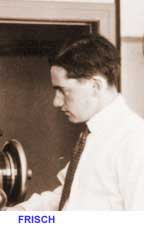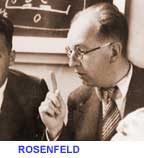Meitner and her nephew continued their discussion outdoors...
FRISCH: We walked up and down in the snow. I was wearing skis and she said probably she could get along just as fast on her feet, which she did, and gradually we came to the idea that perhaps one should not think of the nucleus being cleaved in half as with a chisel but rather that perhaps there was something in Bohr's idea that the nucleus was like a liquid drop.

Now Meitner and Frisch understood what had happened in Hahn and Strassmann's experiment. The neutrons which they had shot into uranium had indeed been captured by the uranium nucleus. But then the nucleus changed shape, vibrated, and came apart entirely. This was not the usual slight transformation of a nucleus. The picture did fit neatly with a recent theory of Niels Bohr's. He believed that a nucleus behaves like a liquid drop, and a liquid drop hit hard enough, might stretch until it broke in two. Now, if that happened to a nucleus, a lot of energy would be released—atom for atom, far more energy than any process seen till then. Frisch continues the story of his visit...
 |
 |
FRISCH: I think I stayed there for about another day or so. We had Christmas dinner with some Swedish friends, and we discussed a few details. We agreed that we would have to write a paper about this, but we left it to be done separately somehow. It was eventually done in the way that I drafted a paper and read it off to Lise Meitner over the long-distance telephone between Copenhagen and Stockholm, and she would stop me and make comments and suggestions. So it was a slightly expensive way of writing a paper.
My recollection is that when I came back to Copenhagen I found Bohr just on the point of parting, of leaving for America, and I just managed to catch him for five minutes and tell him what we had done. And I hadn't spoken for half a minute when he struck his head with his fist and said, "Oh, what idiots we have been that we haven't seen that before. Of course this is exactly as it must be." And he added, "This is very beautiful," and, had we written a paper? So I said no, we were in the process of writing one.
On his way to America by ocean liner, Bohr developed a more complete explanation of fission. He worked with a colleague, Leon Rosenfeld, who was making the trip with him. Rosenfeld later recalled their efforts...
ROSENFELD: When we met on the boat, he said, "I have in my pocket a paper that Frisch has given me which contains a tremendous new discovery, but I don't yet understand it. We must look at it." Bohr accepted the conclusions because it was an argument directly following from the experiments. But he did not understand why the nucleus would split. And then during the trip that took six days, I suppose or so, he got hold of the solution, and it turned out to be extremely simple.
Meanwhile, back in Denmark, Frisch wanted to check by experiment the idea that uranium can split in two. Several methods could be used to study sub-atomic particles. The easiest was to look at electrical effects in an ionization chamber, using an amplifier and oscilloscope. Invisible particles passing through the chamber would show up as pulses on the screen of the oscilloscope. The hallmark of fission would be the size of the pulses: the two halves of a split atom would have far greater energy than any known particle. Frisch describes his work...
 FRISCH: I rigged up a pulse amplifier for the special purpose, and I also built a small ionization chamber; but the whole thing only took me about two days, and then I worked most of the night through to do the measurements because the counting rates were very low. But by three in the morning I had the evidence of the big pulses. And I went to bed at three in the morning, and then at seven in the morning I was knocked out of bed by the postman who brought a telegram to say that my father had been released from concentration camp.
FRISCH: I rigged up a pulse amplifier for the special purpose, and I also built a small ionization chamber; but the whole thing only took me about two days, and then I worked most of the night through to do the measurements because the counting rates were very low. But by three in the morning I had the evidence of the big pulses. And I went to bed at three in the morning, and then at seven in the morning I was knocked out of bed by the postman who brought a telegram to say that my father had been released from concentration camp.
 By this time Frisch and Meitner had finished writing their joint paper, in which they interpreted the Hahn-Strassmann results as nuclear fission. Frisch meanwhile wrote a second paper about his new experiments which confirmed their guess...
By this time Frisch and Meitner had finished writing their joint paper, in which they interpreted the Hahn-Strassmann results as nuclear fission. Frisch meanwhile wrote a second paper about his new experiments which confirmed their guess...
FRISCH: They were both sent to Nature at the same day but Nature published one after the other. And I might still mention that the word "fission" occurs in the first paper and was suggested to me by an American biologist, William A. Arnold, whom I asked what you call it when a cell divides itself.
